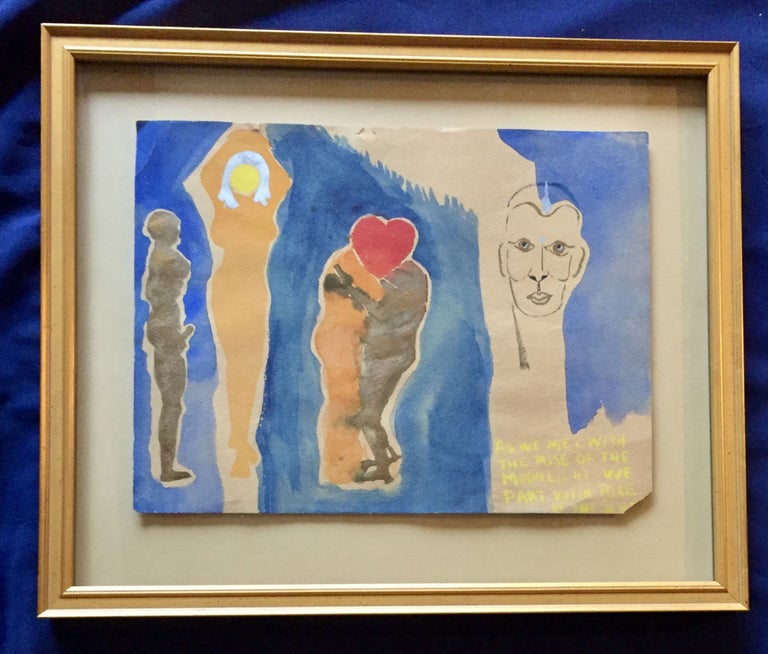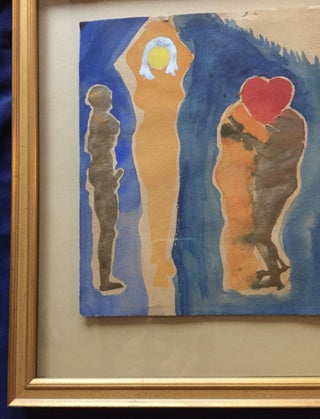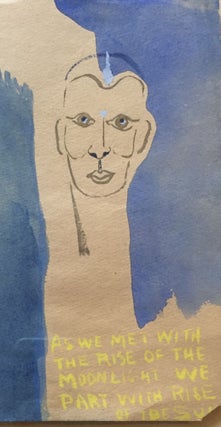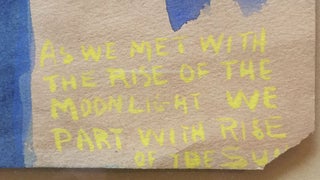"AS WE MET WITH THE RISE OF THE MOONLIGHT / WE PART WITH THE RISE OF THE SUN"
San Francisco: Justin Hein, ca. 1963. Justin Hein. Original. Framed and glazed. Original watercolor painting by Justin Hein given to his partner, Glenn Todd, about 1963, and created in San Francisco.
Description: Watercolor painting: (23 x 30 cm / 9 ¼" x11 ¾"); in frame (34 x 40.5 cm / 13 ¼ x 16"). Glazed & in a gilt frame.
Item number:
303866. Near Fine / Framed & glazed. Item #3892
This painting is a pointed, flagrant yet poignant expression of the Beat Scene in San Francisco during the mid-60's. It is an emblem of a central dynamic of the love affairs between Glenn Todd, Justin Hein, and Maggie Harms--as furtther elucidated in Todd's memoir The Book of Friends: Scenes from Life on Gough St..
Glenn Todd (born 1930), who was the recipient of this painting by his lover, Justin Hein, hailed from Archer City,Texas. Glenn served in the U.S. Army; then attended Wichita State University. Thereafter, he graduated from UCal, Berkeley.
For a number of years, Glenn--and close friends like Dave Haselwood and Justin Hein--resided at 1403 Gough Street in San Francisco. Their large multi-room pad became an important creative refuge for the San Francisco Beat-&-Hippy scene, which included several significant artists, poets, and their publishers.
In 1964, near the time of this painting, Glenn followed his roomie, Dave Haselwood, into limited edition publishing.
Haselwood (d.December 29, 2014) also was from Wichita, Kansas, then abuzz with wannabe artists and poets. Dave was then friends with painter-filmmaker Bruce Conner and poet Michael McClure. Then, in 1957, David came to San Francisco to study at SF State, but in 1958, he dropped out to found Auerhahn Press. He published fine, limited and often hand-set platen press editions of poets and artists of the Beat Generation. These included Philip Lamantia, Michael McClure, Philip Whalen, William Burroughs, and others.
In 1961, Dave entered into a partnership with Andrew Hoyem, and together they issued more limited edition press books by Edward Marshall, Lew Welch, Jack Spicer, David Meltzer, Diane Di Prima, Brother Antoninus, and Charles Olson. The books were enhanced by the work of several noteworthy artists.
By 1964, Haselwood and Hoyem ended their unprofitable Auerhahn Press. Nevertheless, with the able assistance of Dave's Gough Street roomie, Glenn Todd, Dave continued to publish avant-garde titles by Lawrence Ferlinghetti, Allen Ginsberg, Charles Plymell, and Joanne Kyger under the imprint of Dave Haselwood Books.
In an overlapping trajectory, Dave's former partner Andrew Hoyem then founded the Grabhorn-Hoyem press from 1966, publishing until Robert Grabhorn and his wife died in 1973. Glenn Todd worked for the press as a journeyman printer.
Thereafter, Andrew Hoyem published extraordinarily fine limited editions of important authors via his magnificent Arion Press. Glenn Todd became an editor for Arion, where he wrote prefaces to several noteworthy publications: one being, Shaped Poetry (2014).
Multi-talented Todd also wrote "The Ballad of Lemon and Crow" (2002) about three generations of Okies. It has illustrations by Bruce Conner, whom Todd had first met in Omaha in 1953, where they were members of another early Beat literary-artistic circle.
Occasional artist Justin Hein (May 28, 1934 - June 2, 2018), like Dave Hasselwood, also had come from Wichita, then a Midwest epicenter aswarm with artist-types who had escapist, drug-&-sex-filled lives. Justin fit right in as an ex-Navy medic turned aspiring artist, swinger, and pothead.
Not long after arriving in Frisco, Justin became another occupant of the Gough Street flat, which has been memorialized in Todd's, The Book of Friends: Scenes from Life on Gough St. (subsequent quotes are to the Kindle edition of 2017). Over time, Justin strove to become Glenn's partner, an important key to his explicit painting captioned, "As We Met With the Rise of Moonlight / We Part With the Rise of the Sun."
With its expressive Beatnik and Hippie themes, Glenn's important memoir brings to life his on-again, off-again swinging, creative, spasmodic life with Justin and others. It promises to become the first installment of a memorable series by multi-talented Todd.
Likewise, Justin Hein's impulsive and colorful painting epitomizes a central dynamic in THE BOOK OF FRIENDS: the on-again, off-again swinging emotional and creative relationships between Justin, Glenn, and Maggie Harms: the woman--with baby Maia--upstairs. (The female silhouette might also stand for other competing women in Todd's active sex life.)
But it also evokes the artsy Beat Generation of Sixties San Francisco often associated with the Haight-Ashbury and less well known Gough Street neighborhoods.
Indeed, during the Fifties, Allen Ginsberg, Peter Orlovsky, and Robert LaVigne had camped out in the Gough Street's 7-room flat and nearby pads. Gough Street had also harbored "countless Beatnik-hipster scenes" before Glenn Todd's "Fool Troop . . . stoned and holy" moved in during the early Sixties. The "Fool Troop" included Justin Hein, Charley Plymell, Marian Weston, Dave Haselwood, Pat Ross, Neal Cassady, Anne Murphy, Dave Moe, Anne Buchannan, and Maggie Harms with her daughter Maia--and others (p.68) Glenn Todd was one of the less well known but very creative Beatniks. Justin rendered his loving sketch of his lover on the right side of this painting.. . .
Lover and occasional artist Justin thus described his spiritual pilgrimage: "[I] went out on a dream. I hitched a ride to the West Coast. I had read Kerouac's On The Road and went out for a big adventure. I went to North Beach, fresh from the Kansas Plains, right after Ginsberg read 'Howl.' I was there for six years, part of a circle of people from Wichita interested in the arts." These included: Dave Haselwood, Michael McClure, Bruce Conner, and Charles Plymell (excerpted from: A Blackout Taverno -Study in 1960's Folklore by Pat O'Connor).
Justin's watercolor reflects his slapdash spontaneity, love of bold colors and transparent symbolism, pointed sexual yearning and deep love for Glenn. It also suggests his alienation; then overcoming of the obstacle to consumation posed by the female silhouette separating the male figures: undoubtedly Maggie Harms.
Given Justin's caption "As We Met With the Rise of the Moonlight, We Part With Rise of the Sun," his lusty artistry suggests a memorable yet covert one-night-stand . . . with beloved Todd, who thus describes some of their intimacies:
"Justin and I flop in the blue alcove under the gold guardian angels" (pp.15-16);
"Contact! Justin has thrown himsself at me, and I have caught him as best I can. He cushions my rigidity. I pull him from his dark retreat. We must hold our relationship to light. We must examine it, turn it in our hands. We must dismantle it, reconstruct it at a moment's notice. We push each other onward to love" (pp.51-52).
The painting expresses the gay--and swinging--lifestyles of San Francisco, and the artistic life that swirled around Glenn Todd, where painters, Beats, hipsters, and literary types gathered within the art and drug scene.
Justin loved to paint sunburst murals, and once painted their door with "a vision of high joy exploding, rising suns of orange and gold, and the word LOVE! across it all in magnificence aflame" (p.12). He also painted above their "bed of love."
Said Todd about Justin the painter: "The real attraction for him is a sunrise that is bursting forth in the corner of the work [Tintoretto's Madonna with Child], flooding the canvas with still, gold light." 'Art just doesn't go far enough,' he [Justin] says" (p.18).
From Todd's autobiographical Book of Friends, we learn that there was another deeply personal aspect implied by the full-figured female silhouette in Heim's painting. For Todd says he had two lovers: not only Justin but also Maggie Harms (p.68; cf.p.64).
Glenn's prior and off-and-on relationship with Maggie may have led to her pregnancy with Maia, with whom she now lived upstairs in a third-floor flat. Thouigh now, she lived chastely with Dave Haselwood, the busy publisher of Beat verse. Yet even while upstairs and out of sight, Maggie was an important image in Todd's mind. He recurrently felt guilt or attraction for her "big round body and her long dark hair..."
"Maggie comes forth sleepily from her bedroom, hair down, looking round and young and naked under her short robe, comes out not entirely unhappy..." (p.8)
Said Glenn: "Maggie, where are you? In a fat girl's dream? I dig those round thighs of yours. You're a Rubens come to life. You'll have to grow more than flesh to keep me away" (p.52).
Glenn's tri-fold relationship with Maggie and Justin wasn't a classic menage à trois, for Todd remained deeply involved and in love serially--swingingly--with his prior inamorata and/or present male companion. Indeed, The Book of Friends includes a photographic companion piece to this painting wherein the trio are seated together on the rim of a flowing fountain with mustachio'd, dark-haired Justin with dark-framed glasses on the left; thick-haired Maggie with Maia in the center; and Glenn happily lounging with cigarette on the right (p.80).
Maggie may have seemed round and Rubens-like, but Justin's painting seems also to have Egyptian overtones suggested by the woman's headdress. (Todd, too, describes another woman living in their pad, as having "a face that turns successively from fashion model to blonde Egyptian princess to poor little witch girl to pale asylum inmate" [p.11; cf.pp. 21-22].)
Indeed, handsome Todd also kept up his sexual interests in other women like Marian of the Ghost Room, dancing Cheryl, and "the rose-blush space" of Joanna (p.50; 63ff.), who had also traversed his orbit. The female outline drawn by Justin thus seems to represent more than Maggie, but also an Eternal Female and a generalized female avatar.
If the Egyptian motif is present, this suggests that the ithyphallic man may be another "Egyptianized" figure: Justin-as-Osiris in a phallic role. (Compare Robert LaVigne's painting of nude Peter Orlovsky that Todd long kept "of the ideal Narcissy, that neat pick curve of his cock" (p.67), better known as "Nude with Onions," 1954 (image available on the web).
Which description of the painting is best? Is it merely "I've got a hard-on for you?" Or is it powerful affection cloaked with slgiht esoteric symbolism and an expression of flagrant sexual desire no longer thwarted?
A clue may lie in Justin's Catholic upbringing and deep religiousity, which mingled with the religious syncretism that swirled about the Gough Street pad on fumes of pot and LSD.
Compare the clustering of religious figures in Allen Ginsberg's "Wichita Vortex Sutra," where he invokes icons of transcendence—Christ, Allah, Jaweh, William Blake, and various Indian holy men. Dave Haselwood, too, became so deeply immersed in Zen that he eventually became ordained as a priest; thereafter being known as "Joko Dave." In spite of deeper dimensions, t
he scene on Gough Street was not to last: "After being away for six years, Justin moved back to Wichita where he stayed close to family" and worked in the family business.
Hein's Heart, though, was "left in San Francisco," for in memoriam, he painted his a bold red heart over the two embracing men. Todd refers to this sign of personal symbolism as "the Ace of Hearts" in his memoir [p.48].
About Justin's departure, Todd became wistful:
"Goodbye. How can I leave these rooms where we have loved? That we beautified with life? No more music in the Blue Room, nor Justin-placed flowers on the round table pushing loveliness into the air, fulfilling space. The gold cloth comes down from above our bed of love, where more than once I lay awake in woe" (p.37).
"Only Justin is somewhere in silent sadness; it's his last week on his skid-row job; he's leaving to pursue his Magnificat vision of Bachbursting light and I can see the dark strugggle toward self-love in his eyes and I long to cry Let me help, I can too love, but I can't stop now--I can only be ready to leap when the moment is gold" (p.42).
Condition:
Lower right corner of yellow inscription chipped though legible; slight smearing to central figures embracing beneath red heart, else Very Good.
References:
Allen Ginsberg's, "Wichita Vortex Sutra."
Pat O'Connor, A Blackout Tavern, accessed on the Web, January 27, 2019.
Charles Plymell, Wikipedia entry.
Rolf Potts listing on the web of: An outsider’s inside history of the Beat Generation, as told by Charles Plymell, dated Nov. 8, 2018.
Glenn Todd's, The Book of Friends: Scenes from Life on Gough St. (quotes are to the Kindle edition).
Provenance: From the estate of Glenn Todd via auction.
Price: $2,500.00






